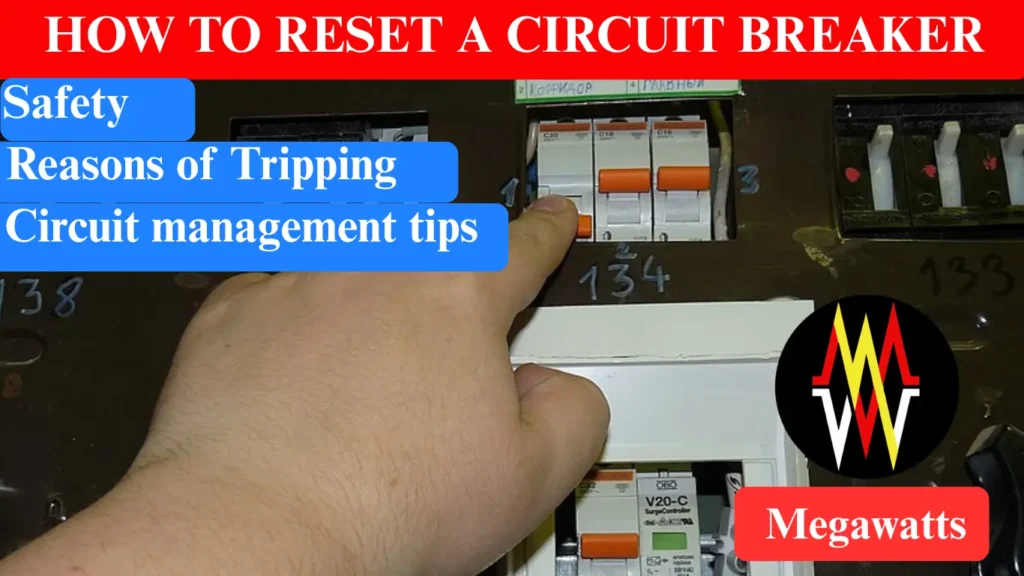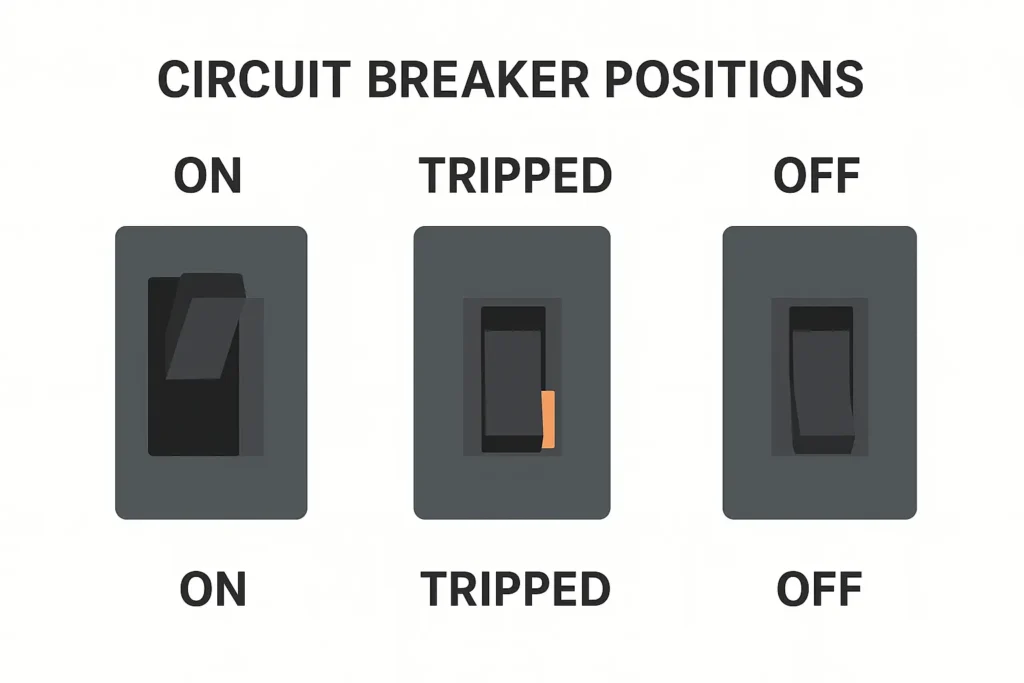
Knowing how to reset a circuit breaker is though underrated but still essential skill in daily life. Circuit breakers are used in an electrical circuit to make or break the circuit. After the break of the circuit, electrical isolation of the circuit is achieved. It protects the circuit from various electrical faults such as overloading, overcurrent, arc faults, and ground faults. After the circuit breaker trips, meaning its contacts get separated, breaking the circuit, the power flow in the circuit stops. In order to restore power back in the circuit, it is important to know how to reset the circuit breaker.
Table of Contents
Why did the circuit breaker trip?
Before knowing how to reset a circuit breaker, it is important to know why did the circuit breaker tripped? The reason behind the circuit breaker tripping will determine if it is safe to reset the circuit breaker and charge the circuit.
The most common reasons for circuit breaker tripping
Overload: When an electrical circuit is overloaded, meaning the current in the conductor of the circuit is more than the rated capacity of the conductor, then the electrical conductor heats up and it can cause significant degradation of the electrical insulation of the conductor. The overloading condition results from using too many power-intensive devices in a circuit. The circuit breaker commonly trips in this condition as it detects any overloading of the circuit.
Short-circuit: A short-circuit occurs when a hot line touches a neutral wire completing the circuit short. In this case, a huge surge of current passes in the circuit which can potentially damage the circuit and can start a fire too. The circuit breaker instantly trips protecting the circuit against such faults.
Ground fault: Ground fault is when the live wire touches the ground or grounded structure, often caused by moisture and degraded insulation. These faults can risk human safety and hence the circuit breaker trips the electrical circuit upon detection of such faults.
Faulty appliance: In case of a faulty appliance connected to the circuit, the circuit breaker will detect the fault and trip.
Aging: A circuit breaker can also trip unnecessarily because of aging, mechanical wear over time and internal corrosion or oxidization in presence of moisture.
Tools & equipment needed
Before touching any electrical panel, the personnel safety must be ensured. Safety is the first step before learning how to reset a circuit breaker
Insulated Gloves and shoes: It is essential to wear insulated gloves and shoes for protection of a person.
Flashlight: It is important to carry a flashlight and use it if the electrical panel is in dark area. Often when circuit breaker trips, lighting too may fail, therefore flashlight is much needed for the vision of the person even knowing how to reset a circuit breaker.
Multimeter or voltage tester: This tool is needed to confirm the presence or absence of power in the terminals of the circuit breaker.
Dry area: It is essential to dry out the hands before touching any electrical equipment and also standing on a dry area is equally important as to knowing how to reset a circuit breaker.
Circuit Labelling: Labelling of the circuit or knowing which circuit is used to operate which appliances is must.
Caution: NEVER RESET A CIRCUIT BREAKER STANDING IN A WET AREA.
How to reset a circuit breaker
Step1: Locate the electrical panel which houses the circuit breakers. In home, it is usually near the entrance, garage or basement. For industry or substations, it is in the control room or switchgear panel. Knowing the electrical layout is the important foundation in how to reset a circuit breaker safely and efficiently.
Step 2: Open the panel door and many circuit breakers will appear in a row, we have to identify the tripped circuit breaker. A tripped circuit breaker usually rests in the middle position which is between ON and OFF. Also an orange or red indicator will be there beside the tripped circuit breaker.

Step 3: After identification of the tripped circuit breaker, make sure to disconnect all appliance from the tripped circuit. This ensures no circuit overload upon energization or restoration. For industry and substation practice, all loads from the tripped feeder must be isolated first. This is an important step in the guide How to Reset a Circuit Breaker as it will reduce the tripping of the circuit breaker, if the fault is in appliances connected.
Step 4: Switch the breaker to OFF position, this will clear the internal trip mechanism and prepare the circuit breaker for reset. If this step is skipped, the circuit breaker may not latch properly in ON position.
In substation practice, all the picked up relay (protection relays and master trip relay) of the associated circuit breaker has to be reset, this is done via SCADA or from the switchgear control panel. Check the gas or oil level of the circuit breaker. After this, interlocks must be checked and verified including the local and remote switch to prepare for charging of the circuit breaker.
Step 5: Put the circuit breaker to ON position, most circuit breaker gives a tactile feedback, if the circuit breaker stays in ON position, power will be restored in the affected circuit and how to reset a circuit breaker is successfully learned. But, if the circuit breaker trips again, some fault persists in the circuit and the circuit has to be checked.
Step 6: Once the circuit breaker stays ON after charging, connect appliances to the circuit one after other and observe, when the breaker trips again. If the breaker holds ON position without tripping, the power is restored in the circuit, but if it trips after connecting a specific appliance, then it is inferred that specific appliance is the cause of tripping. This step completes the practical guide on how to reset a circuit breaker.
In substation practice, all tripping and closing time of the circuit breaker has to be logged in a logbook.
Professional help seeking for how to reset a circuit breaker
A licenced electrician must be called for in case:
- The circuit breaker is tripping even with minimal load ( less than rated).
- After resetting of circuit breaker, foul smell of burning is noticed along with heating of the panel.
- If sparks were noticed in the process of resetting the circuit breaker.
- If after the reset of circuit breaker the load is fluctuating like flickering of lights.
- In case of substation, if the circuit breaker is not resetting and re-energizing, call the protection engineers.
Tips for Circuit Management:
Labelling of circuit breakers: The circuit breakers must be labelled for the circuit it is installed in. It helps with the overview of the electrical circuits in the system and also reduces time during faulty breaker identification.
Use of AFCI and GFCI circuit breakers: The use of these specialized circuit breakers add layers of protection to the circuit.
Regular inspection: Annual inspection of the electrical system must be done and preventive maintenance must be undertaken upon any serious findings.
Avoid DIY wiring: Poor wiring is the source of circuit breaker tripping and electrical hazards and hence it must be avoided at all cases.
Never force a circuit breaker to stay ON, if it trips, check the circuit and then restore power.
This article, How to reset a circuit breaker is a part of the Switchgear, where other articles related to switchgear are discussed in details.
How do you know if a breaker needs to be reset?
If a breaker needs reset, it will give no tactile feedback while bushing it towards ON position. Hence, it is very essential to know how to reset a circuit breaker properly and safely.
How many times can we reset a circuit breaker?
Although there is no specific numbers, resetting one time after tripping of the circuit breaker is necessary for charging it again.
What happens when you reset a breaker?
When the breaker is reset, the operating mechanism resets, allowing it to hold the ON position and continue tripping again on detection of fault.
Should I unplug everything before resetting the breaker?
Yes, it is advisable to unplug and turn off every appliances in the affected circuit before resetting the breaker.
